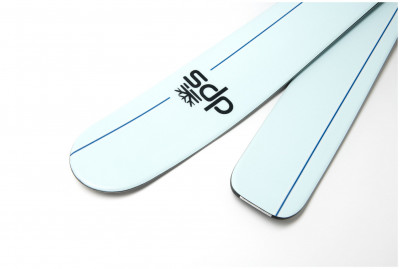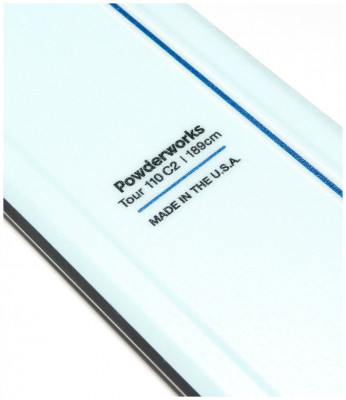DPS Powderworks Tour 110 Dreamtime Ski
Taken on their own, “DPS,” “Powderworks,” and “Dreamtime” are words known for making head turns and eyes pop. Altogether, the DPS Powderworks Tour 110 C2 Dreamtime Ski is enough to trigger satori, a Zen term best understood as insight into the luminous nature of reality itself. With their Dreamtime series, DPS annually unveils a few models intended to inspire excitement for the future while recalling their own past lineage. The Powderworks Tour 110 is obviously reminiscent of the brand's smooth, surfy Lotus and Spoon models, but is built from a C2 all-mountain chassis. Increasing the effective edge makes these skis a top choice for hard-charging hero turns on firm snow while retaining the massive platform necessary for planing above low-density powder. With a relatively flat tail, hook-free tip, and substantial camber, these skis are built to crash downhill at speed without diving too deep below the surface. At its core, this ski is still built from DPS’s signature touring Paulownia and ash wood plus aerograde foam, which together are remarkably effective at dampening vibration and resisting damage. Lest we forget, the clean Dreamtime graphics are a nice look too. Traditional spiritual practice requires years of dedicated effort in the hopes of catching a glimpse of the Truth. Turns out it might be possible to taste it yourself with the Powderworks Tour 110 C2 Dreamtime Ski!
- Pagoda Tour build integrates a textured polyamide cap to shed snow, wood/foam core to dampen vibration, and full sidewalls derived from algae to increase longevity and biodegradability!
- Directional C2 shape is shared with Pagoda Tour 87, 94, and 106.
- Rocker and effective edge are calibrated to ensure a 22-meter turn radius across all lengths.
- "Dreamtime" refers to the 65,000 year old Aboriginal Australian cosmology of the same name.
- Another little-known fact: DPS stands for the founder's last initial ("D") plus PowderworkS.
| Specifications | |
| Lengths (cm) | 171, 179, 184, 189 |
|
Weight |
1410g [171] 1530g [179] 1575g [184] 1655g [189] |
| Weight (pair) | 2820g [171] 3060g [179] 3150g [184] 3310g [189] |
|
|
134-110-118 [171] 135-110-119 [179] 136-110-120 [184] 137-110-121 [189] |
|
Turn |
22m [All sizes] |
|
Skin |
Round tip, flattish tail |
| Specs Verified | Yes |
| Design | |
|
|
25-35% Rocker, 65-75% Effective edge |
|
|
Tapered tip, sidecut, tapered tail |
|
|
Pagoda Tour (Poulownia and ash plus foam) |
|
|
Paulownia, ash, aerospace foam |
| Skimo Co Says | |
| Usage | Charging backcountry lines |
| Notes | 'Dreamtime' top sheet separates this special edition ski from others in the Pagoda Tour family |
| Bottom Line | Lightweight on the up, heavyweight on the down |
| Compare to other Excess-fat Skis | |
Related Products
Questions & Reviews
They're very damp for how light they are, even on pretty hard snow. It's impressive. The rocker profile and camber under foot are all very subtle - Tip/tail rocker is modest and gentle not going way far in toward the ski on either end, and the camber is quite low. This combines to make them just loose enough to be fun, but with plenty of running length to edge great and track which is great considering something this light/still can be twitchy. Also means the 179 is perfect where I needed a 184 in the old 112RP and 186 in the RPC. Very curious to get them in deep snow (maybe this week!) given the lower rocker, but given how the old Pure 3 Wailer 105 skied pow at a much higher weight, I'm not worried.
In 3D snow, they track well and don't surprise you, though they are a bit tapered in those low-slung tips so they do want to turn more than something w/o taper. They don't force you to turn constantly like shorter-radius skis - their quickness in trees and tight spots is - for me - more about picking them up and shifting angles quickly given how light they are rather than using the sidecut to noodle.
Like other carbon skis, these benefitted MASSIVELY from some aggressive edge detuning. They're very stiff both torsionally and longitudinally. Given that, I don't also want sharp edges. Before I detuned, they were quite jumpy and twitchy, which is common. Huge thanks to the Skimo team for answering my questions and getting them to me quickly!
They are somewhat similar, but obviously wider and have slightly deeper rocker lines especially in the tip. A little more powder oriented, and a longer turn radius. Overall, the 106 is a bit more of an all-arounder, whereas the 110 is more of a powder/big mountain charger. Both are damp, powerful skis, but the 110 will want to ski harder and faster, and will certainly be right at home in the deep stuff.
Not quite the same profile, but not too dissimilar! This ski shares a longer turn radius of 22 meters, and a longer tip rocker with subtle tail rocker. The main differences would be the narrower width and the Pagoda construction, as well as a bit more camber underfoot. This ski is based on the C2 shape, which is DPS's more traditional, directional shape designed for all-mountain performance. Compared to the Lotus 124 in the Tour1 construction, this ski would be more damp and versatile across different snow types, with a lot more composure on firmer snow. It also might feel like it has a bit more energy to it coming out of the turn. Overall, it would be a sweet powder-oriented charger that can handle variable conditions quite well.
Bindings depend on more than the ski they are paired with. I would recommend filling out a Binding Finder. We would be happy to point you in the direction of a binding that suits your needs!
On the DPS Powderworks Tour 110 Dreamtime in the179cm length, DPS recommends a mount point of 78.4cm off the tail. Note that this is for boot center line, not pin line.
Is the mount point common on C2 chassis?
Is there a factory +1 / +2
The recommended mount point on the Tour 110 Dreamtime varies based on the length. Reach out to help@skimo.co with the size you wish to ski, and we can get that number for you.
The mount point is not consistent across all C2 shaped skis, but the Tour 110 is closer to a traditional mount point than a progressive one. On this ski, we generally suggest going with the recommended. No need to go +1 or -1 unless you have a compelling reason.
Earn store credit by writing reviews. Learn more.




















